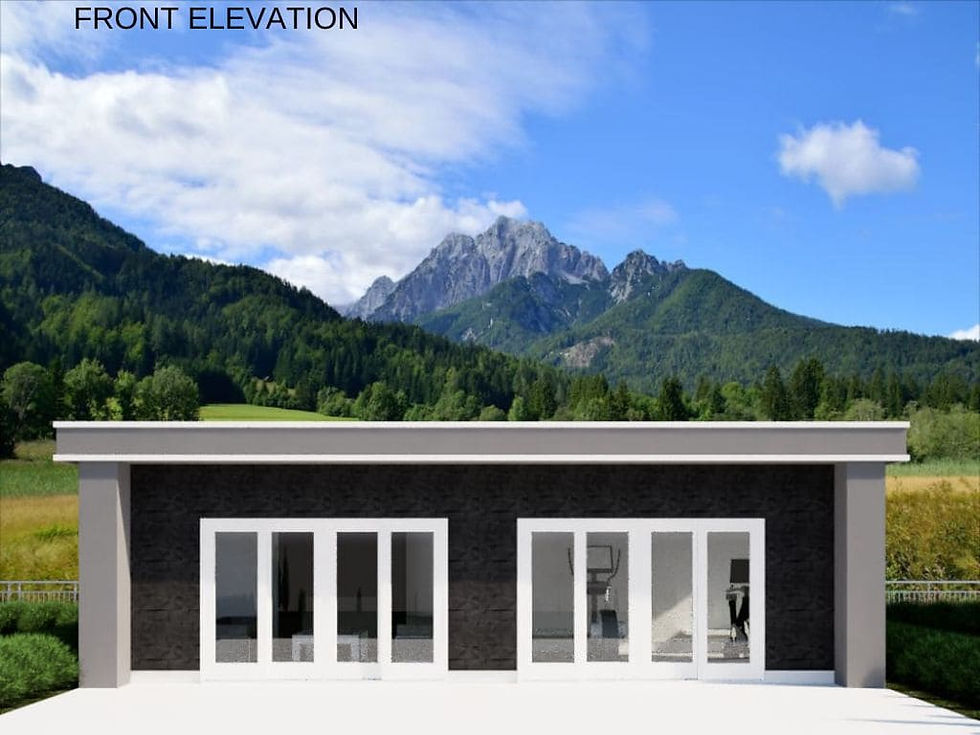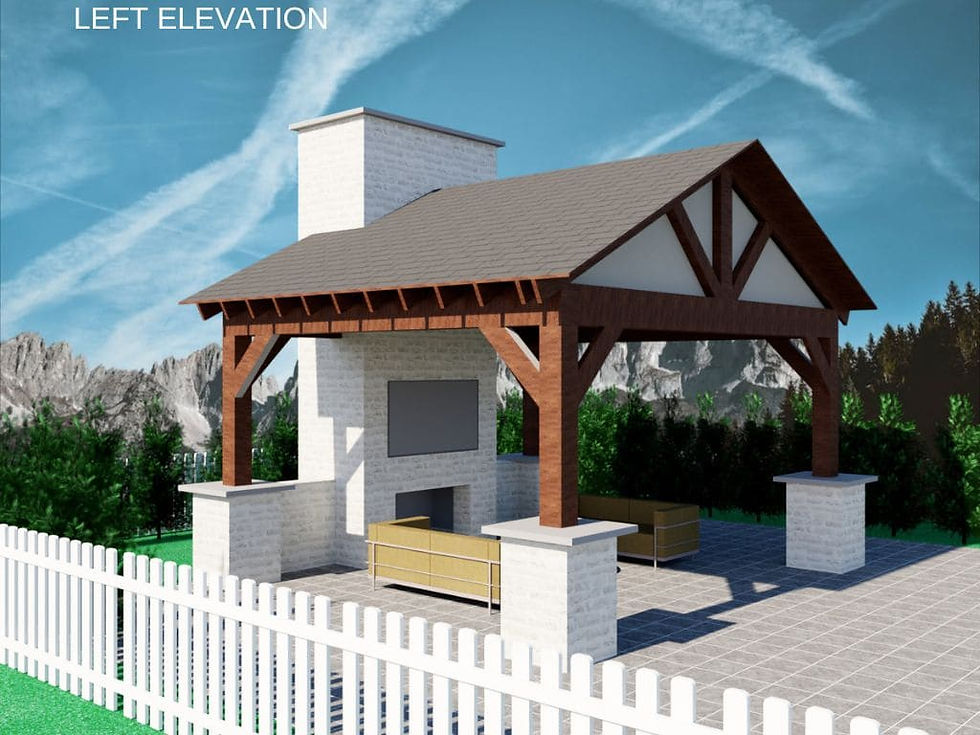5 Types of Roofs You Need to Consider
- Vijaykumar Patel

- Jun 16, 2023
- 4 min read
Updated: Feb 20, 2024
Table of Contents (Press on the desired topic to quickly navigate to it)
#1 Introduction
To ensure a building's lifespan, toughness, and aesthetic appeal, selecting the appropriate roof is essential when designing one. In addition to improving the building's functioning, a well-designed roof raises the value of your home.
It's important to understand the features, benefits, and drawbacks of the numerous roof varieties that are offered. You may choose the type of roof that best fits your demands and budget with the help of this information. This post will discuss 5 various roof types that you should take into account.
The Shelter of excuses has a leaky roof. - Ron Kaufman
Low slope or no slope, which results in a horizontal surface on top of the building, are features of flat roofs.
They are often used in commercial structures and contemporary residences and are generally constructed of materials like PVC, TPO, EPDM, or modified bitumen.
To stop water from leaking into the building, waterproof membranes can be applied to flat roofs either entirely or partially.
Advantages
Cost-effective
Easy maintenance
Space utilization
Energy efficiency
Disadvantages
Drainage issues
Limited design options
Susceptibility to leaks
A shed roof is a single-sloped roof with a single downward slope, often from a taller wall to a lower one.
It is a straightforward and useful roof style that is frequently used for functional buildings like sheds, barns, and even pool houses.
Advantages
Cost-Effective
Easy to Construct
Good Drainage
Provide Shade
Customized Size
Disadvantages
Limited headroom
Limit the amount of usable Space
A gable roof consists of two sloping sides that meet at a ridge at the top, forming a triangular shape.
Advantages
Most Common Roof
Efficient Rainwater and snow Runoff.
Additional Attic Space or Storage Space
Additional Natural Light & Ventilation with the use of Dormer Windows
Disadvantages
Less energy-efficient than other roof designs due to the large Attic Space
Moisture problems and mold growth if not Ventilated Properly
More expensive to install and requires additional framing support.
Table: Gable Roof VS HIP Roof Different Component
Roof Component | Gable Roof | Hip Roof |
Shape | Two sloping sides forming a triangular shape | All four sides slope down towards the walls |
Drainage | Efficient rainwater runoff due to steep slopes | Good drainage due to multiple slopes |
Attic Space | Additional attic space or storage | Limited attic space due to the slopes |
Natural Light & Ventilation | More natural light and ventilation with dormer windows | Adequate natural light and ventilation |
Energy Efficiency | Less energy-efficient due to larger attic space | Relatively more energy-efficient |
Stability | Less wind resistance compared to hip roofs | High stability and wind resistance |
Snow Load | Efficient snow shedding | Suitable for moderate snow loads |
Cost | $4 to $6 per square foot (Material + Installation) | $8 to $12 per square foot (Material + Installation) |
Maintenance | Easier maintenance | Slightly more maintenance due to additional slopes |
Aesthetic Appeal | Traditional appearance | Balanced and elegant look |
Suitable for | Areas with mild weather | Regions with moderate snow or rainfall |
Installation | Easier installation with less framing support | May require more framing and labor |
Source: Today's Homeowner
A hip roof is a style of roof that has a ridge or peak in the middle where the slopes on all four sides meet.
Hip roofs often have gradual slopes, making them suitable for locations with minimal snowfall or rainfall.
The hip roof style is excellent for locations subject to hurricanes or strong winds because it offers considerable wind resistance and stability.
Advantages
Provides good stability and wind resistance
Good choice for areas with moderate amounts of snow or rainfall.
The design sense of elegance and architectural interest in a pool house.
Disadvantages
May be more expensive
Require more maintenance over time.
Limit the amount of Interior space
#6 Mansard Roof
a roof design that has two slopes, the bottom slope being steeper than the top slope.
In addition, a French roof, curb roof, or gambrel roof may be used.
Advantages
Additional space for storage or living
Allows for a lot of natural light and ventilation
Creates an elegant and distinctive look to any building
Disadvantages
More expensive
As a result of its complicated design, it can need extra upkeep and repairs.
Installing solar panels or other rooftop equipment may be more difficult.
#7 Conclusion
Your roof selection is a crucial choice that has to be carefully considered. The temperature in your region, the style and appearance of your building, your financial situation, and your tastes are a few things to think about. Flat roofs, gable roofs, hip roofs, and mansard roofs are a few prominent roof styles.
Each offers unique benefits and drawbacks, so it's critical to conduct a thorough study and speak with experts before making a choice. Take your time and thoroughly consider your alternatives before deciding on a roof for your dream project because the best solution will ultimately rely on your particular demands and circumstances.
Do flat roofs leak more frequently than other types of roofs?
Because of their low pitch, flat roofs can be more prone to leaks, although new waterproofing techniques and materials have substantially increased their dependability. Leakage risk can be reduced by using high-quality waterproof membranes, performing proper installation, and performing routine maintenance.
Frequently Asked Questions: Can shed roofs be used on houses?
Yes, shed roofs are not only seen on useful structures like sheds or barns. In particular for modern or minimalist designs, they can be employed for residential buildings. Shed roofs are both aesthetically pleasing and economically constructed.
What distinguishes a gable roof from other types of roofs?
As a result of the excellent runoff that gable roofs provide from rain and snow, moisture issues and the growth of mold are reduced. With the help of dormer windows, they also offer extra attic or storage space and permit more natural light and ventilation.
Are hip roofs appropriate for regions with significant snowfall?
In general, regions with moderate snowfall or rainfall are better suited for hip roofs. They may not be as effective at shedding high snow loads due to their gentle slopes. However, the hip roof is a fantastic option for areas subject to hurricanes or heavy winds due to its stability and wind resistance.
Why are mansard roofs more expensive than other types of roofs?
Having two slopes in their complex shape, mansard roofs may necessitate more labor and materials during construction. The additional area they offer also raises the price. Additionally, the form of the roof may make it more difficult to install rooftop equipment like solar panels.
*Please note that the information shared in our blog is for educational purposes only, and we do not assume any liability for the actions or decisions made based on this information.








Comments